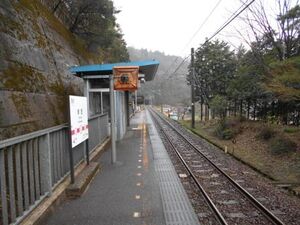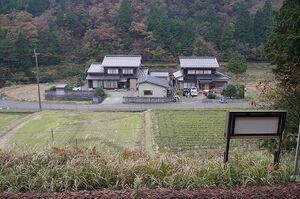
Karakawa I
| Karakawa I | |||||
|---|---|---|---|---|---|
| Japanese Name | 初代カラカワ | ||||
| Weapon | |||||
| Race | Beast | ||||
| Nationality | |||||
WIP.
Trivia
- Karakawa the First's beast motif is the cat.
- Karakawa I was a member of the original Ooe Big Four (大江山四天王), alongside Ooenomiya, Shimoamazu I, and Futamata I, she is Karakawa's mother.
- Karakawa I has lost her right arm defending Shimoamazu I from Daiyaki's assault as the latter attempts to seal the oni. At present, she wears a prosthetic arm.
Counterpart
Karakawa Station (辛皮駅) is a passenger railway station in located in the city of Miyazu, Kyoto Prefecture, Japan, operated by the private railway company Willer Trains (Kyoto Tango Railway). Opened on July 16, 1988, Karakawa Station is a station of the Miyafuku Line, and is located 21.3 kilometers from the terminus of the line at Fukuchiyama Station. The station consists of one side platform serving a single bi-directional track. The station is categorized as a halt and is unattended.
The number of users for Karakawa station is extremely small (less than 3 passengers a day on average). On March 16, 2013, the timetable for the line was revised to have one rapid train bound for Fukuchiyama to stop here in the evening for the convenience of high school students who attend school from this station to Miyazu station. Rapid "Oeyama" No. 2 stops only for Fukuchiyama. There are no more users for Karakawa station, and thus there are no trains that stop by this halt starting from the timetable revision on March 4, 2017 unless upon request by travelers.
Ownership of Karakawa station is transferred from Miyafuku Line to Willer Trains on April 1, 2015, becoming a station on the Kyoto Tantetsu Railway Miyafuku Line.
On the west side of the station, the Higashi River of the Yura River system flows north-to-south, and there are fields on both banks of the river, where private houses are scattered. The Kyoto Jukan Expressway (Ayabe Miyazu Road) runs along the railroad track on the mountain slope on the east side of the station. Wikipedia
Karakawa station is famous in Japan as a "Hikyō station" (秘境駅). Hikyō station is the Japanese language name for railway stations that are little used and isolated. The Japanese term hikyō eki was invented by Takanobu Ushiyama and his friends when he began a website in 1999 dedicated to these stations. He subsequently wrote two books: "Hikyo-eki e Iko!" (Let's go to hikyo-eki!), published by Shogakukan Inc. in 2001 and "Motto Hikyo-eki e Iko!" (Let’s go to more hikyo-eki!), published in 2003.
Hikyō stations are generally located in areas that previously had a sizeable human population due to mountain climbing and related activities, but currently have very few inhabitants and houses. Because of this lack of population, the trains no longer make regular stops, and train and rail fans have adopted these as popular locations for visiting. Because of the lack of regular passenger custom, the stations see little use these days, and many are being considered for closure.
In order for a train station to be classified as a "Hikyō", all of the following requirements have to be met:
- Unexploredness - The surrounding area is surrounded by cliffs, deep forests, and desolate wilderness, and there are no or almost no houses.
- Atmosphere - The station building, waiting room, and surrounding buildings appears to be old or worn down.
- Difficulty of reaching via trains - There are very few trains that stop, and/or it is difficult to reach the unexplored station by train.
- Difficulty of reaching via car - High grade is granted when there are no roads to reach the station, followed by difficulty in visiting the unexplored station by car or motorcycle, such as only sidewalks and unpaved forest roads.
- Railroad Heritage Index - There are railroad remains such as switchbacks, loop lines, drop lines, and abandoned railway tracks. This requirement was added after the 2012 revision of the ranking criteria. Wikipedia
Map
Gallery
- Pages using Tabber parser tag
- Pages using DynamicPageList3 parser tag
- Weapon Sword
- Beast
- Nishiki
- Non-Playable Characters
- Train Knights
- Japan








